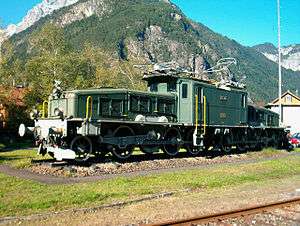Crocodile (locomotive)
|
Crocodile Ce 6/8II in Erstfeld | |||||||||||||||||||||||||||
| |||||||||||||||||||||||||||
| |||||||||||||||||||||||||||
| |||||||||||||||||||||||||||
| |||||||||||||||||||||||||||
Crocodile (German Krokodil) electric locomotives are so called because they have long "noses" at each end, reminiscent of the snout of a crocodile (see also Steeplecab). These contain the motors and drive axles, and are connected by an articulated center section. The center section usually contains the crew compartments, pantographs and transformer.
The name was first applied to Swiss locomotives. Sometimes the term is applied to locomotives in other countries of a similar design.
History
Switzerland
- Class Ce 6/8
A prototype locomotive, SBB-CFF-FFS Ce 6/8 I number 14201, was ordered in June 1917. The production "Crocodiles" were the series SBB Ce 6/8 II and SBB Ce 6/8 III locomotives of the SBB, Swiss Federal Railways, built between 1919 and 1927. There were 33 class Ce 6/8 II and 18 class Ce 6/8 III, making a total (excluding the prototype) of 51 locomotives. These locomotives were developed for pulling heavy goods trains on the steep tracks of the Gotthardbahn from Lucerne to Chiasso, including the Gotthard Tunnel.
The electric motors available at the time were large and had to be body-mounted above the plane of the axles, but flexibility was required to negotiate the tight curves on the Alpine routes and tunnels. An articulated design, with two powered nose units bridged with a pivoting center section containing cabs and the heavy transformer, met both requirements and gave excellent visibility from driving cabs mounted safely away from any collision. The two motors in each nose unit were geared to a jackshaft between the drive axles farthest from the cab, with side rods carrying the power to the drivers. These locomotives, sometimes called the "Swiss Crocodile" or "SBB Crocodile", were highly successful and served until the 1980s. Märklin published a book about their history in 1984.[2] Several are still in operation as preserved historical locomotives.
- Class Be 6/8
Between 1942 and 1947, thirteen members of class Ce 6/8 II were upgraded with more powerful motors, to allow a higher top speed, and these became class Be 6/8 II. This required raising the jackshaft above the plane of the axles, necessitating a more complex system of side rods. In 1956, all eighteen members of class Ce 6/8 III were upgraded and became class Be 6/8 III.[3]
- Narrow gauge

As well as standard gauge Crocodiles, there are also narrow gauge versions. The best known are the Rhaetian Railway (RhB)'s metre gauge locomotives of class Ge 6/6 I, the Rhaetian Crocodile. Several of these still run on passenger trains on special occasions. They are also used on freight trains in busy periods. The Bernina Railway (later merged with the RhB) also built a single Crocodile type, the Ge 4/4, nicknamed the 'Bernina Crocodile'. This locomotive survives and is being restored to operating condition.
Two other Swiss narrow-gauge railways also have locomotives nicknamed Crocodiles; the BVZ Zermatt-Bahn (BVZ) (which merged with the Furka-Oberalp-Bahn (FO) in 2003 to form the Matterhorn-Gotthard-Bahn) uses series HGe 4/4 I, known as the Zermatt crocodile, while the Chemin de Fer Yverdon-Ste. Croix owns a solitary class Ge 4/4 #21. Neither of these locomotive types have an articulated body, which leads some railfans to nickname them "false crocodiles".
Austria
Very similar locomotives were used in Austria as Austrian Federal Railways (Österreichische Bundesbahn) classes ÖBB 1089 and ÖBB 1189, and are often known as 'Austrian Crocodiles'.
Germany
The German classes E 93 and E 94, also used by the ÖBB as series 1020, are sometimes called 'German crocodiles'. They are sometimes nicknamed "Alligators", instead, because of their broader, shorter snouts.
France
The French DC 25 kV CC locomotives of series 14000 and 14100 of the SNCF, used mainly for iron ore trains on the Thionville-Valencienne line, were also nicknamed "crocodile".
India
Crocodile locomotives were also used in India. These locomotives, of series WCG-1, were used from 1928 between Bombay and Pune, and were all built to the Indian broad gauge of 5 ft 6 in (1676 mm). The first 10 locomotives were built by Swiss Locomotive and Machine Works. Vulcan Foundry of Great Britain constructed a further 31 examples for this line.[4][5]
Other Crocodile-like locomotives
The articulated-body design was not unique to the Crocodiles. It was used in the United States on the Milwaukee Road class EP-2 "Bi-Polars", for example.
Many more locomotives adopted the design of long noses without articulation of the body. The single GE 4/4 of the Yverdon–Ste-Croix railway was known as the 'Crocodile', despite being an elongated Bo-Bo steeplecab with articulated bogies beneath, rather than an articulated locomotive. This extended to painting it with large crocodile heads on each side.
Video Game Appearances
- It appears in Chris Sawyer's Locomotion in the Alpine Scenario, introduced in 1920 and obsolete by 1965.
- It appears as one of the purchasable trains in Sid Meier's Railroads!, named the Ge 6/6 Crocodile. It was a mixed traffic engine capable of 64 km/h and available for $80,000.
- It is available as a free download on the Auran Download Station for the entire Trainz series.
- ÖBB 1189 from virtualRailroads is purchasable for RailWorks Train Simulator 2012.
- The locomotive appears in Urban Games' Train Fever and Transport Fever in the European vehicle sets of both titles. In Train Fever, the locomotive has a top speed of 40 mph, but has an increased speed of 47 mph in the successor title Transport Fever.
References
- ↑ "SWISS Ce 6". Personal.umich.edu. Retrieved 2013-03-19.
- ↑ Stammer, H. S. "Märklin Krokodil." (Gebr. Märklin & Cie., 1984).
- ↑ "SWISS Ce 6". Personal.umich.edu. Retrieved 2013-03-19.
- ↑ "[IRFCA] Indian Railways FAQ: Locomotives - Specific classes : DC & Dual Current Electric". Irfca.org. Retrieved 2013-03-19.
- ↑ http://irfca.org/docs/VulcanFoundry_GIPR_Electric.pdf
External links
| Wikimedia Commons has media related to Crocodile (locomotive). |

